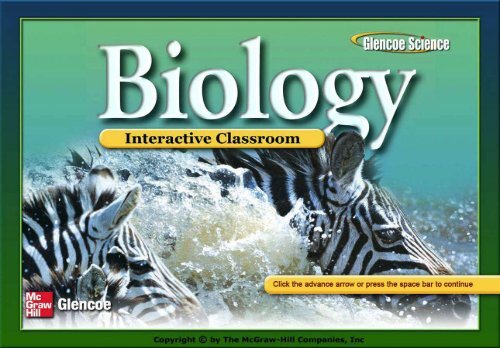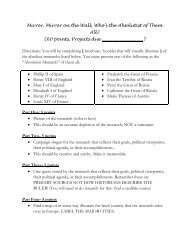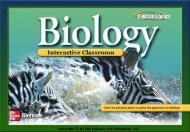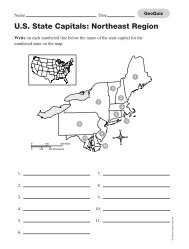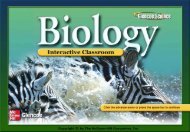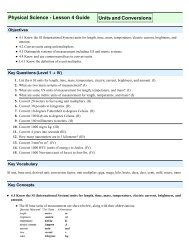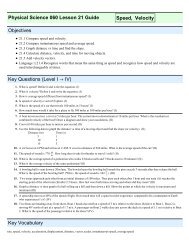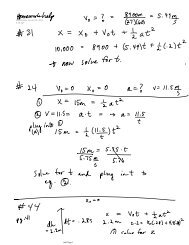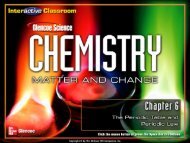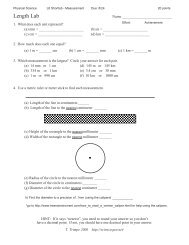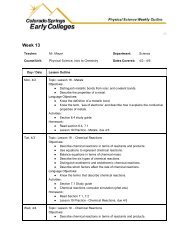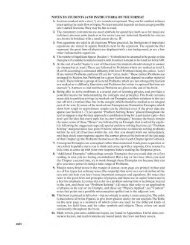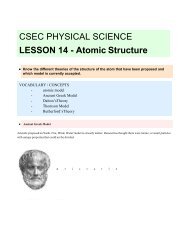Chapter 33 The Nervous System.pdf
Chapter 33 The Nervous System.pdf
Chapter 33 The Nervous System.pdf
You also want an ePaper? Increase the reach of your titles
YUMPU automatically turns print PDFs into web optimized ePapers that Google loves.
<strong>Chapter</strong> <strong>33</strong> <strong>Nervous</strong> <strong>System</strong>Section 1:Structure of the <strong>Nervous</strong> <strong>System</strong>Section 2: Organization of the <strong>Nervous</strong> <strong>System</strong>Section 3: <strong>The</strong> SensesSection 4: Effects of DrugsClick on a lesson name to select.
<strong>Chapter</strong> <strong>33</strong><strong>Nervous</strong> <strong>System</strong><strong>33</strong>.1 Structure of the <strong>Nervous</strong> <strong>System</strong>• Dendrites pass signals they receive on to thecell body in electrical impulses.• <strong>The</strong> axon passes those impulses on to theother neurons or muscles.
<strong>Chapter</strong> <strong>33</strong><strong>Nervous</strong> <strong>System</strong><strong>33</strong>.1 Structure of the <strong>Nervous</strong> <strong>System</strong>• <strong>The</strong>re are three kinds of neurons: sensoryneurons, interneurons, and motor neurons.• Sensory neuronssend impulses fromreceptors in the skinand sense organs tothe brain and spinalcord.• Interneurons carry impulses to motor organs.
<strong>Chapter</strong> <strong>33</strong><strong>Nervous</strong> <strong>System</strong><strong>33</strong>.1 Structure of the <strong>Nervous</strong> <strong>System</strong>• Motor neurons carry impulses away from thebrain and spinal cord to a gland or muscles,resulting in a secretionor movement.• <strong>The</strong> nerve impulsecompletes a reflexarc, or a nervepathway thatconsists of a sensory neuron, an interneuron,and a motor neuron.
<strong>Chapter</strong> <strong>33</strong><strong>Nervous</strong> <strong>System</strong><strong>33</strong>.1 Structure of the <strong>Nervous</strong> <strong>System</strong>A Nerve Impulse• Neurons at restdo not conductimpulses.• Sodium ions (Na + )collect on the outsideof the cell membrane.
<strong>Chapter</strong> <strong>33</strong><strong>Nervous</strong> <strong>System</strong><strong>33</strong>.1 Structure of the <strong>Nervous</strong> <strong>System</strong>• Potassium ions (K+)collect on the inside ofthe cell membrane.• Negatively chargedproteins activelytransport sodium ionsout of the cell andpotassium ions into the cell.
<strong>Chapter</strong> <strong>33</strong><strong>Nervous</strong> <strong>System</strong><strong>33</strong>.1 Structure of the <strong>Nervous</strong> <strong>System</strong>An Action Potential• A nerve impulse is also known as an actionpotential.• <strong>The</strong> minimumstimulus to cause anaction potential to beproduced is called athreshold.
<strong>Chapter</strong> <strong>33</strong><strong>Nervous</strong> <strong>System</strong><strong>33</strong>.1 Structure of the <strong>Nervous</strong> <strong>System</strong>• When a stimulus reachesthreshold, channels openin the plasma membrane.• Sodium ions are rapidlypumped through thesechannels causing atemporary change in theelectrical charges.• More positive charges arenow inside the membrane.
<strong>Chapter</strong> <strong>33</strong><strong>Nervous</strong> <strong>System</strong><strong>33</strong>.1 Structure of the <strong>Nervous</strong> <strong>System</strong>• <strong>The</strong> now positive chargeinside the membranecauses other channels toopen and the potassiumis quickly pumped out ofthe cell.• <strong>The</strong> potassium restoresthe positive chargeoutside the cell.
<strong>Chapter</strong> <strong>33</strong><strong>Nervous</strong> <strong>System</strong><strong>33</strong>.1 Structure of the <strong>Nervous</strong> <strong>System</strong>• This rapid positive tonegative to positivecharge reversal movesalong the axon like awave.• <strong>The</strong> movement can beseen by finding thesodium-potassiumreversal pattern in thethree diagrams.
<strong>Chapter</strong> <strong>33</strong><strong>Nervous</strong> <strong>System</strong><strong>33</strong>.1 Structure of the <strong>Nervous</strong> <strong>System</strong>Speed of an Action Potential• Nodes along the axon allow ions to passthrough the myelin layer to the plasmamembrane.• <strong>The</strong> ions jump from node to node andincrease the speed of the impulse.VisualizingAction Potential
<strong>Chapter</strong> <strong>33</strong><strong>Nervous</strong> <strong>System</strong><strong>33</strong>.1 Structure of the <strong>Nervous</strong> <strong>System</strong><strong>The</strong> Synapse• <strong>The</strong> small gap between the axon of oneneuron and the dendrite of another neuronis called a synapse.• An action potential is carried across thesegaps by neurotransmitters.
<strong>Chapter</strong> <strong>33</strong><strong>Nervous</strong> <strong>System</strong>
<strong>Chapter</strong> <strong>33</strong><strong>Nervous</strong> <strong>System</strong><strong>33</strong>.2 Organization of the <strong>Nervous</strong> <strong>System</strong>• <strong>The</strong> nervous systemconsists of two majordivisions: the centralnervous system andthe peripheral nervoussystem.
<strong>Chapter</strong> <strong>33</strong><strong>Nervous</strong> <strong>System</strong><strong>33</strong>.2 Organization of the <strong>Nervous</strong> <strong>System</strong><strong>The</strong> Central <strong>Nervous</strong> <strong>System</strong>• <strong>The</strong> central nervous system (CNS) is madeup mostly of interneurons.• Coordinates all of the body’s activities• Relays messages, processes information,and analyzes responses
<strong>Chapter</strong> <strong>33</strong><strong>Nervous</strong> <strong>System</strong><strong>33</strong>.2 Organization of the <strong>Nervous</strong> <strong>System</strong><strong>The</strong> Brain• <strong>The</strong> brain issometimes calledthe control centerof the entire body.• Divided into thecerebrum, thecerebellum, andthe brain stem.
<strong>Chapter</strong> <strong>33</strong><strong>Nervous</strong> <strong>System</strong><strong>33</strong>.2 Organization of the <strong>Nervous</strong> <strong>System</strong>• <strong>The</strong> cerebrum is divided into two halvescalled the left and right hemispheres.• <strong>The</strong> functions of the brain include thoughtprocesses (learning), memory, language,speech, voluntary body movements, andsensory perception.
<strong>Chapter</strong> <strong>33</strong><strong>Nervous</strong> <strong>System</strong><strong>33</strong>.2 Organization of the <strong>Nervous</strong> <strong>System</strong>• <strong>The</strong> cerebellum controls balance, posture,and coordination.• <strong>The</strong> skeletal muscles are controlled to makeyour motor skills coordinated and smooth.
<strong>Chapter</strong> <strong>33</strong><strong>Nervous</strong> <strong>System</strong><strong>33</strong>.2 Organization of the <strong>Nervous</strong> <strong>System</strong>• <strong>The</strong> brain stem connects the brain andspinal cord and is composed of the medullaoblongata and the pons.• <strong>The</strong> medulla oblongata helps control breathingrate, heart rate, and blood pressure.• <strong>The</strong> pons also aids in breathing.
<strong>Chapter</strong> <strong>33</strong><strong>Nervous</strong> <strong>System</strong><strong>33</strong>.2 Organization of the <strong>Nervous</strong> <strong>System</strong>• <strong>The</strong> hypothalamus, located between thebrain stem and the cerebrum, is essentialfor homeostasis.• Regulates body temperature, thirst, appetite,and water balance.
<strong>Chapter</strong> <strong>33</strong><strong>Nervous</strong> <strong>System</strong><strong>33</strong>.2 Organization of the <strong>Nervous</strong> <strong>System</strong><strong>The</strong> Spinal Cord• Nerve column thatextends from the brainto the lower back.• Protected by thevertebrae• Processes reflexes
<strong>Chapter</strong> <strong>33</strong><strong>Nervous</strong> <strong>System</strong><strong>33</strong>.2 Organization of the <strong>Nervous</strong> <strong>System</strong><strong>The</strong> Peripheral <strong>Nervous</strong> <strong>System</strong>• A nerve is a bundle of axons and may containsensory and motor neurons.• <strong>The</strong> peripheral nervous system (PNS) containsall the neurons that are not part of the centralnervous system.
<strong>Chapter</strong> <strong>33</strong><strong>Nervous</strong> <strong>System</strong><strong>33</strong>.2 Organization of the <strong>Nervous</strong> <strong>System</strong><strong>The</strong> Somatic <strong>Nervous</strong> <strong>System</strong>• Nerves in the somatic nervous system relayinformation from external sensory receptors tothe central nervous system, and motor nervesrelay information from the central nervoussystem to skeletal muscles.• Voluntary movements and reflexes are a partof the somatic nervous system.
<strong>Chapter</strong> <strong>33</strong><strong>Nervous</strong> <strong>System</strong><strong>33</strong>.2 Organization of the <strong>Nervous</strong> <strong>System</strong><strong>The</strong> Autonomic <strong>Nervous</strong> <strong>System</strong>• <strong>The</strong> autonomic nervous system carriesimpulses from the central nervous systemto the heart and other internal organs.• <strong>The</strong> body responds involuntarily, not underconscious control.
<strong>Chapter</strong> <strong>33</strong><strong>Nervous</strong> <strong>System</strong><strong>33</strong>.2 Organization of the <strong>Nervous</strong> <strong>System</strong>• <strong>The</strong>re are two branches of the autonomicnervous system.• <strong>The</strong> sympathetic nervous system is mostactive in times of emergency or stress whenthe heart rate and breathing rate increase.• <strong>The</strong> parasympathetic nervous system is mostactive when the body is relaxed.
<strong>Chapter</strong> <strong>33</strong><strong>Nervous</strong> <strong>System</strong>
<strong>Chapter</strong> <strong>33</strong><strong>Nervous</strong> <strong>System</strong><strong>33</strong>.3 <strong>The</strong> SensesTaste and Smell• Specialized neurons in your body enable youto taste, smell, hear, see, and touch, and todetect motion and temperature.• Taste buds detect combinations of chemicalsthat we identify as sweet, sour, salty, andbitter.
<strong>Chapter</strong> <strong>33</strong><strong>Nervous</strong> <strong>System</strong><strong>33</strong>.3 <strong>The</strong> Senses• Receptors associatedwith taste and smellare located in themouth and nasalcavity.• Signals from thesereceptors worktogether to createa combined effect in the brain.
<strong>Chapter</strong> <strong>33</strong><strong>Nervous</strong> <strong>System</strong><strong>33</strong>.3 <strong>The</strong> SensesSight• Light travels through the cornea and the pupilto the lens.• <strong>The</strong> lens focusesthe image on theretina.• Rods and cones inthe retina providelight-sensitivity and information about color.
<strong>Chapter</strong> <strong>33</strong><strong>Nervous</strong> <strong>System</strong><strong>33</strong>.3 <strong>The</strong> SensesHearing• Sound waves enter the auditory canal andcause a membrane,called the tympanum,at the end of the earcanal to vibrate.• <strong>The</strong>se vibrationscause the cochlea to generate nerve impulsesthat are interpreted by the brain.
<strong>Chapter</strong> <strong>33</strong><strong>Nervous</strong> <strong>System</strong><strong>33</strong>.3 <strong>The</strong> SensesBalance• <strong>The</strong> semicircular canals, located in theinner ear, transmit information about bodyposition and balance to the brain.
<strong>Chapter</strong> <strong>33</strong><strong>Nervous</strong> <strong>System</strong><strong>33</strong>.3 <strong>The</strong> SensesTouch• Many types ofsensory receptorsthat respond totemperature,pressure, and painare found in theepidermis anddermis layers ofthe skin.
<strong>Chapter</strong> <strong>33</strong><strong>Nervous</strong> <strong>System</strong><strong>33</strong>.4 Effects of DrugsHow Drugs Work• A drug is a substance, natural or artificial,that alters the function of the body.
<strong>Chapter</strong> <strong>33</strong><strong>Nervous</strong> <strong>System</strong>
<strong>Chapter</strong> <strong>33</strong><strong>Nervous</strong> <strong>System</strong><strong>33</strong>.4 Effects of Drugs• Some drugs affect the nervous system in thefollowing ways:• can cause an increase in the amount of aneurotransmitter that is released into a synapse• can block a receptor site on a dendrite,preventing a neurotransmitter from binding• can prevent a neurotransmitter from leavinga synapse• can imitate a neurotransmitter
<strong>Chapter</strong> <strong>33</strong><strong>Nervous</strong> <strong>System</strong><strong>33</strong>.4 Effects of Drugs• Many drugs that affect the nervous systeminfluence the level ofa neurotransmittercalled dopamine.• Normally, dopamineis removed from asynapse by beingreabsorbed by the neuron that released it.
<strong>Chapter</strong> <strong>33</strong><strong>Nervous</strong> <strong>System</strong><strong>33</strong>.4 Effects of DrugsClasses of Commonly Abused Drugs• Stimulants• Drugs that increase alertness andphysical activity• Nicotine• Caffeine
<strong>Chapter</strong> <strong>33</strong><strong>Nervous</strong> <strong>System</strong><strong>33</strong>.4 Effects of DrugsDepressants• Drugs that tend to slow down the centralnervous system• Alcohol• Inhalants• Illegal drugs
<strong>Chapter</strong> <strong>33</strong><strong>Nervous</strong> <strong>System</strong><strong>33</strong>.4 Effects of DrugsTolerance and Addiction• Tolerance occurs when a person needs moreand more of the same drug to get the sameeffect.• <strong>The</strong> psychological and/or physiologicaldependence on a drug is addiction.
<strong>Chapter</strong> <strong>33</strong><strong>Nervous</strong> <strong>System</strong><strong>Chapter</strong> Resource Menu<strong>Chapter</strong> Diagnostic QuestionsFormative Test Questions<strong>Chapter</strong> Assessment QuestionsStandardized Test Practicebiologygmh.comGlencoe Biology TransparenciesImage BankVocabularyAnimationClick on a hyperlink to view the corresponding lesson.
<strong>Chapter</strong> <strong>33</strong><strong>Nervous</strong> <strong>System</strong><strong>Chapter</strong> DiagnosticQuestionsWhich is not one of the main parts ofa neuron?A. axonB. cell bodyC. dendritesD. nucleus
<strong>Chapter</strong> <strong>33</strong><strong>Nervous</strong> <strong>System</strong><strong>Chapter</strong> DiagnosticQuestionsAnother name for a nerve impulseis _______.A. synapseB. thresholdC. reflex arcD. action potential
<strong>Chapter</strong> <strong>33</strong><strong>Nervous</strong> <strong>System</strong><strong>Chapter</strong> DiagnosticQuestionsWhat occurs when a motor neuronsynapses with a muscle cell?A. muscle contractsB. muscle relaxesC. painD. numbness
<strong>Chapter</strong> <strong>33</strong><strong>Nervous</strong> <strong>System</strong><strong>33</strong>.1 FormativeQuestionsWhat type of neuron begins a reflex arc?A. interneuronB. motor neuronC. sensory neuronD. transmitter neuron
<strong>Chapter</strong> <strong>33</strong><strong>Nervous</strong> <strong>System</strong><strong>33</strong>.1 FormativeQuestionsWhat is another name for nerve impulse?A. synapsisB. thresholdC. action potentialD. neurotransmitter
<strong>Chapter</strong> <strong>33</strong><strong>Nervous</strong> <strong>System</strong><strong>33</strong>.1 FormativeQuestionsTrue or FalseA stronger stimulus will cause a strongeraction potential.
<strong>Chapter</strong> <strong>33</strong><strong>Nervous</strong> <strong>System</strong><strong>33</strong>.1 FormativeQuestionsWhen a neuron is atrest, what maintainsthe high concentrationgradients of potassiumions inside the cell andsodium ions outsidethe cell?
<strong>Chapter</strong> <strong>33</strong><strong>Nervous</strong> <strong>System</strong><strong>33</strong>.1 FormativeQuestionsA. diffusionB. osmosisC. active transportD. ion channels
<strong>Chapter</strong> <strong>33</strong><strong>Nervous</strong> <strong>System</strong><strong>33</strong>.2 FormativeQuestionsWhich is not part of the central nervoussystem?A. brainB. spinal cordC. interneuronsD. sensory neurons
<strong>Chapter</strong> <strong>33</strong><strong>Nervous</strong> <strong>System</strong><strong>33</strong>.2 FormativeQuestionsWhat does the cerebrum regulate?A. breathing and heart ratesB. complex motor skillsC. sleep, aggression, and fearD. voluntary body movements
<strong>Chapter</strong> <strong>33</strong><strong>Nervous</strong> <strong>System</strong><strong>33</strong>.2 FormativeQuestionsTrue or FalseSome reflexes are processed only in thespinal cord and do not need input from thebrain.
<strong>Chapter</strong> <strong>33</strong><strong>Nervous</strong> <strong>System</strong><strong>33</strong>.2 FormativeQuestionsWhat is a nerve?A. a bundle of axonsB. a chain of neuronsC. a sensory synapseD. a series of impulses
<strong>Chapter</strong> <strong>33</strong><strong>Nervous</strong> <strong>System</strong><strong>33</strong>.2 FormativeQuestionsWhat part of the nervous system is usuallyunder voluntary control?A. autonomic nervous systemB. somatic nervous systemC. sympathetic nervous systemD. parasympathetic nervous system
<strong>Chapter</strong> <strong>33</strong><strong>Nervous</strong> <strong>System</strong><strong>33</strong>.3 FormativeQuestionsWhat are sensory receptors?A. cells that create action potentials andthresholdsB. localized areas of the central nervoussystemC. chemicals that cross a synapse betweentwo nerve cellsD. specialized neurons for detecting theworld around you
<strong>Chapter</strong> <strong>33</strong><strong>Nervous</strong> <strong>System</strong><strong>33</strong>.3 FormativeQuestionsWhich part of the eye contains lightdetectingreceptors?
<strong>Chapter</strong> <strong>33</strong><strong>Nervous</strong> <strong>System</strong><strong>33</strong>.3 FormativeQuestionsWhat is the function of the optic nerve?A. It forms a visual image.B. It controls the muscles of the iris.C. It interprets light intensity and colors.D. It sends action potentials to the brain.
<strong>Chapter</strong> <strong>33</strong><strong>Nervous</strong> <strong>System</strong><strong>33</strong>.3 FormativeQuestionsWhere are sound vibrations convertedinto nerve impulses?
<strong>Chapter</strong> <strong>33</strong><strong>Nervous</strong> <strong>System</strong><strong>33</strong>.3 FormativeQuestionsWhere are the sensory receptors thatdetect your body’s position and motion?
<strong>Chapter</strong> <strong>33</strong><strong>Nervous</strong> <strong>System</strong><strong>33</strong>.4 FormativeQuestionsWhy is caffeine a drug?A. It is a depressant.B. It is an artificial substance.C. It influences the nervous system.D. It builds tolerance to its effects.
<strong>Chapter</strong> <strong>33</strong><strong>Nervous</strong> <strong>System</strong><strong>33</strong>.4 FormativeQuestionsWhich neurotransmitter is influenced bynicotine and amphetamines, and is involvedwith most types of addiction?A. adenosineB. dopamineC. epinephrineD. serotonin
<strong>Chapter</strong> <strong>33</strong><strong>Nervous</strong> <strong>System</strong><strong>33</strong>.4 FormativeQuestionsWhich is not a stimulant?A. alcoholB. caffeineC. nicotineD. methamphetamine
<strong>Chapter</strong> <strong>33</strong><strong>Nervous</strong> <strong>System</strong><strong>33</strong>.4 FormativeQuestionsWhat is the term for the body’s decreasedresponse to a drug?A. addictionB. dependenceC. toleranceD. withdrawal
<strong>Chapter</strong> <strong>33</strong><strong>Nervous</strong> <strong>System</strong><strong>33</strong>.4 FormativeQuestionsWhen people who are addicted try to quit, whyis it difficult to resist going back to the drug?A. Adenosine levels increase.B. Dopamine levels decrease.C. <strong>The</strong> central nervous system slows down.D. Action potentials in neurons becomestronger.
<strong>Chapter</strong> <strong>33</strong><strong>Nervous</strong> <strong>System</strong><strong>33</strong>.4 FormativeQuestionsTrue or FalsePhysiological dependence on a drug isstronger than psychological dependence.
<strong>Chapter</strong> <strong>33</strong><strong>Nervous</strong> <strong>System</strong><strong>Chapter</strong> AssessmentQuestionsName the part ofthe brain that isresponsible formemory.A. hypothalamusB. medulla oblongataC. cerebrumD. cerebellum
<strong>Chapter</strong> <strong>33</strong><strong>Nervous</strong> <strong>System</strong><strong>Chapter</strong> AssessmentQuestionsContrast the functions of the cerebellumand the cerebrum.Answer: <strong>The</strong> cerebellum controls balance,coordination, and motor skills.<strong>The</strong> cerebrum controls learning,memory, speech, voluntary bodymovements, and sensoryperception.
<strong>Chapter</strong> <strong>33</strong><strong>Nervous</strong> <strong>System</strong><strong>Chapter</strong> AssessmentQuestionsWhat part of thebrain is identified inthe image?A. ponsB. cerebrumC. hypothalamusD. medulla oblongata
<strong>Chapter</strong> <strong>33</strong><strong>Nervous</strong> <strong>System</strong>Standardized TestPracticeHow do nerve impulses travel in a neuron?A. dendrite cell body axonB. dendrite cell body axonC. dendrite cell body axon
<strong>Chapter</strong> <strong>33</strong><strong>Nervous</strong> <strong>System</strong>Standardized TestPracticeWhat carries signals from the axon of oneneuron to the dendrite of another neuron?A. interneuronsB. ion channelsC. neural nodesD. neurotransmitters
<strong>Chapter</strong> <strong>33</strong><strong>Nervous</strong> <strong>System</strong>Standardized TestPracticeWhich word best describes thehypothalamus?A. processorB. reflexorC. regulatorD. transmitter
<strong>Chapter</strong> <strong>33</strong><strong>Nervous</strong> <strong>System</strong>Standardized TestPracticeWhat part of the brain is highly developedin animals that have finely tuned balanceand complex coordination?A. cerebellumB. medullaC. thalamusD. temporal lobe
<strong>Chapter</strong> <strong>33</strong><strong>Nervous</strong> <strong>System</strong>Standardized TestPracticeHow do the sympathetic and parasympatheticnervous systems act together?A. <strong>The</strong>y send and receive neurotransmitters.B. <strong>The</strong>y send opposing signals to the sameorgans.C. <strong>The</strong>y balance voluntary and involuntaryresponses.D. <strong>The</strong>y receive the same impulses fromdifferent receptors.
<strong>Chapter</strong> <strong>33</strong><strong>Nervous</strong> <strong>System</strong>Standardized TestPracticeWhy is this receptorlocated closest to thesurface of the skin?
<strong>Chapter</strong> <strong>33</strong><strong>Nervous</strong> <strong>System</strong>Standardized TestPracticeA. It detects cold.B. It detects heat.C. It detects heavy pressure.D. It detects light touch.
<strong>Chapter</strong> <strong>33</strong><strong>Nervous</strong> <strong>System</strong>Standardized TestPracticeWhat substances in the body are mostclosely associated with a drug’s influenceon the nervous system?A. endorphinsB. Na + and K + ionsC. neurotransmittersD. proteins
<strong>Chapter</strong> <strong>33</strong><strong>Nervous</strong> <strong>System</strong>Standardized TestPracticeWhere in the nerve pathway do drugshave their primary effect?A. axonsB. dendritesC. synapsesD. myelin sheaths
<strong>Chapter</strong> <strong>33</strong><strong>Nervous</strong> <strong>System</strong>Standardized TestPracticeWhich step is blocked by cocaine?
<strong>Chapter</strong> <strong>33</strong><strong>Nervous</strong> <strong>System</strong>Glencoe Biology Transparencies
<strong>Chapter</strong> <strong>33</strong><strong>Nervous</strong> <strong>System</strong>Image Bank
<strong>Chapter</strong> <strong>33</strong><strong>Nervous</strong> <strong>System</strong>VocabularySection 1neurondendritecell bodyaxonreflex arcaction potentialthresholdnodesynapseneurotransmitter
<strong>Chapter</strong> <strong>33</strong><strong>Nervous</strong> <strong>System</strong>VocabularySection 2central nervoussystemperipheral nervoussystemcerebrummedulla oblongataponshypothalamussomatic nervoussystemautonomic nervoussystemsympatheticnervous systemparasympatheticnervous system
<strong>Chapter</strong> <strong>33</strong><strong>Nervous</strong> <strong>System</strong>VocabularySection 3taste budlensretinarodscochleasemicircular canal
<strong>Chapter</strong> <strong>33</strong><strong>Nervous</strong> <strong>System</strong>VocabularySection 4drugdopaminestimulantdepressanttoleranceaddiction
<strong>Chapter</strong> <strong>33</strong><strong>Nervous</strong> <strong>System</strong>Animation• Visualizing Action Potential• Impulse Movement


